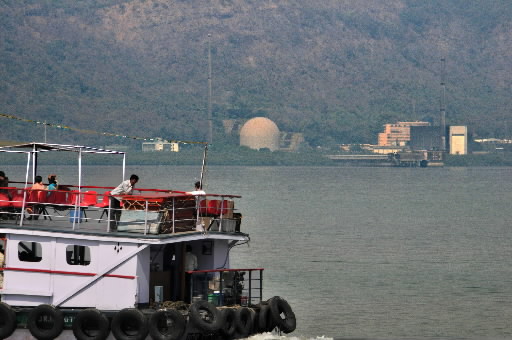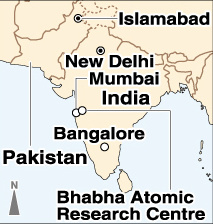Nuclear weapons can be eliminated: Chapter 2, Part 3
Apr. 18, 2009
Chapter 2: South Asia’s cold war
Part 3: Nuclear agreement
by Junichiro Hayashi, Staff Writer
Risk of military use of uranium
Driving through a residential area about 50 kilometers northeast of downtown Mumbai, we approached a facility surrounded by a 2-meter fence. A sign on the iron gate said: “Bhabha Atomic Research Centre.” India’s “nuclear town” faces the Arabian Sea, and behind the walls its spacious grounds accommodate approximately 5,000 households. There are schools and shops as well. It was the base for the nuclear development leading up to India’s first nuclear test in 1974.
We were allowed to visit the Nuclear Power Corporation of India Ltd., a nationally owned company that occupies part of the facility. Sudhinder Thakur, 60, one of the company’s directors, said with a smile, “That was good news. Now the use of nuclear power can proceed even further.” He was referring to the nuclear agreement between the U.S. and India which took effect in October 2008.
Since the conclusion of the agreement, the ban on the importation of nuclear technology and nuclear fuel from the U.S. has been lifted. India, with a population of 1.1 billion, is rapidly modernizing, and along with that its demand for energy is projected to double by 2030. It is national policy--and an essential task for the country--to increase the production of nuclear power under the government-owned corporation.
But not everyone is happy about it.
M.V. Ramana, 42, a physicist in the southern city of Bangalore, shook his head and said, “It’s true that we have a serious shortage of electrical power, but there are too many problems with the agreement.”
India has a small uranium mine. “If we import nuclear fuel from the U.S., the uranium produced in India could be used for military purposes and that could lead to an increase in the production of nuclear weapons,” Dr. Ramana said. In 2006 when negotiations for the agreement were underway, Dr. Ramana conducted a simulation with scientists from the U.S. They concluded that under the agreement the amount of uranium would increase from an amount that could be used to make seven weapons a year to an amount that would permit the manufacture of 40 to 50 weapons.
In addition, the agreement classifies nuclear power facilities into those used for civil purposes and those used for military purposes. Of India’s 22 nuclear reactors, including those under construction, 14 reactors classified for civil use are subject to inspection by the International Atomic Energy Agency, but the eight reactors for military use are exempt. In addition, other reactors, such as those at the Bhabha Atomic Research Centre, will not be inspected and thus international monitoring will be difficult.
In 2007, Dr. Ramana and 19 other experts in India and Pakistan who are concerned about this asked the Japanese government to oppose the agreement between the U.S. and India because one of the conditions for the establishment of the agreement was the approval of the Nuclear Suppliers Group, a 45-nation group of which Japan is a member. But at a special meeting held last fall, NSG members, including Japan, gave their unanimous approval to the agreement.
“With India as a precedent, other countries will boost their supplies of nuclear materials,” Dr. Ramana said. “Even if they are used for energy uses at first, they may be converted to military use when the nation is faced with an enemy.”
Eight days after the U.S.-India agreement took effect, Pakistan announced that it had reached agreement on a nuclear power deal with neighboring China.
(Originally published on March 22, 2009)
To comment on this article, please click the link below. Comments will be moderated and posted in a timely fashion. Comments may also appear in the Chugoku Shimbun newspaper.









